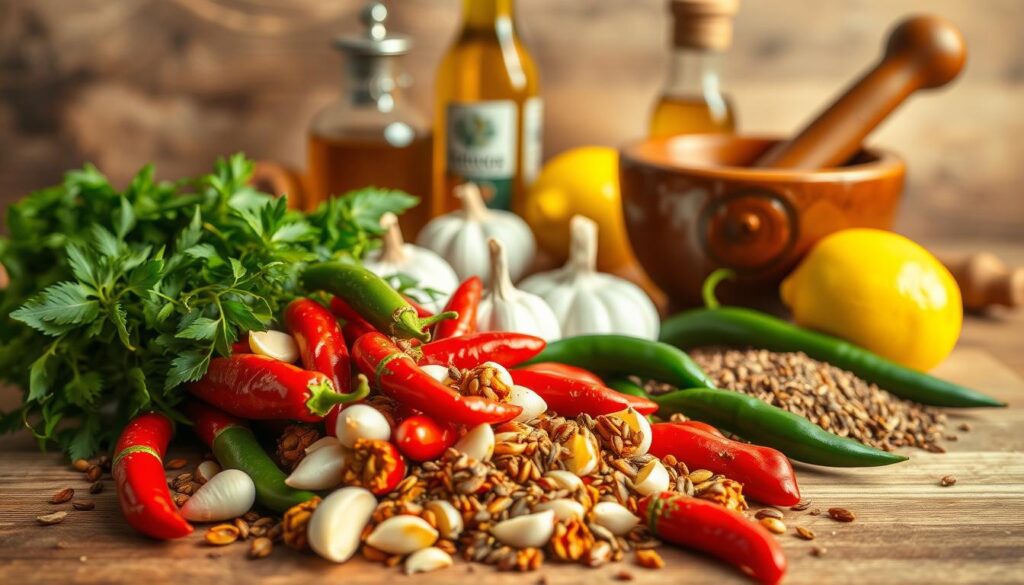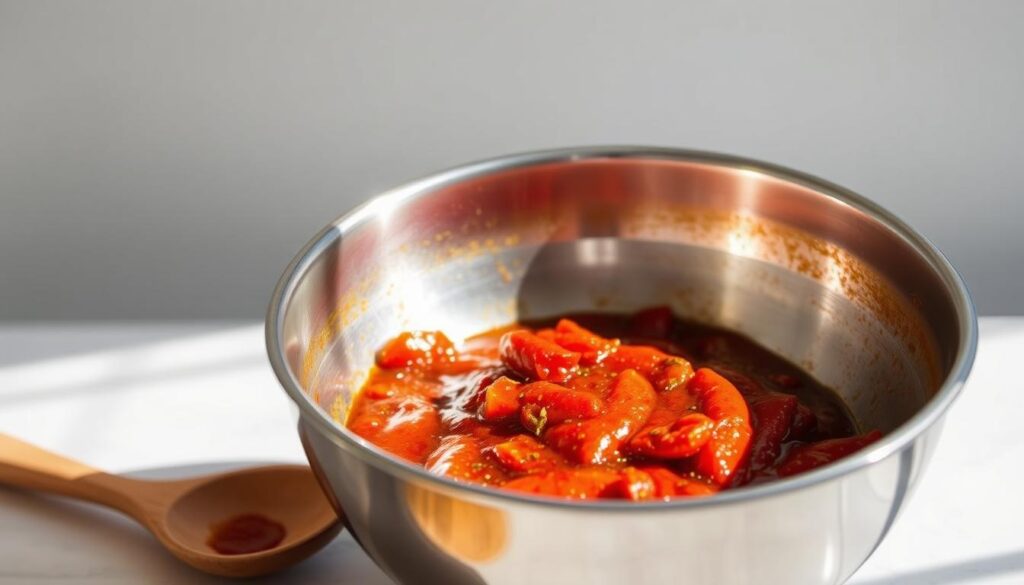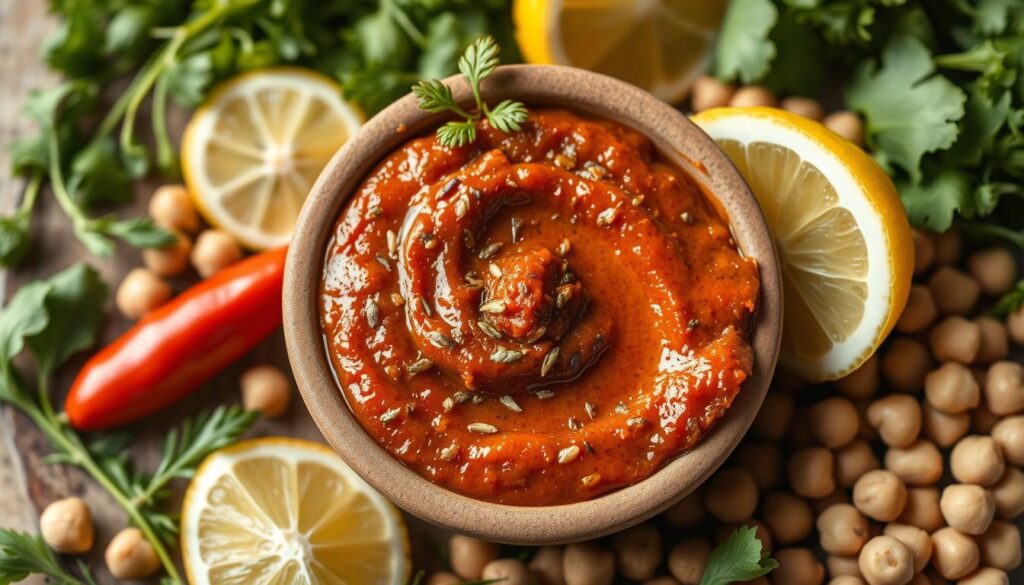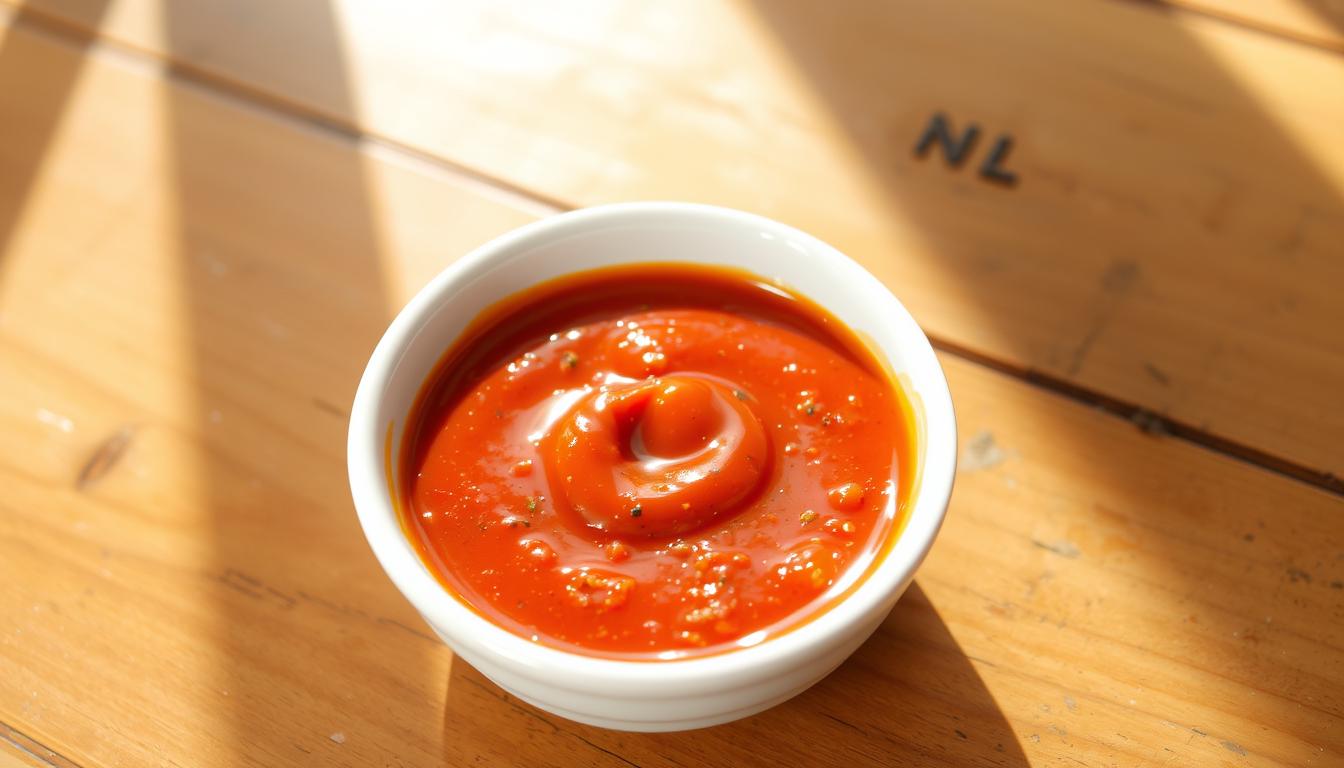Are you tired of bland meals and looking for a way to add a burst of flavor? Spice up your cooking with a condiment that’s both easy to make and versatile.
Making your own homemade harissa sauce is simpler than you think, and it can elevate your dishes from ordinary to extraordinary.
This article will guide you through a quick and easy process to create a delicious harissa sauce that will become a staple in your kitchen.
Key Takeaways
- Learn how to make a delicious harissa sauce at home.
- Discover the benefits of having homemade harissa sauce.
- Understand the simplicity of the recipe.
- Explore the versatility of harissa sauce in various dishes.
- Get tips on customizing the sauce to your taste.
What is Harissa Sauce?
The vibrant flavors of North Africa are encapsulated in harissa sauce, a condiment that has garnered global appreciation. Authentic harissa sauce is a fundamental component of North African cuisine, particularly in countries like Tunisia, Morocco, and Algeria.
Origin and History
Harissa sauce has its roots in the ancient culinary traditions of North Africa. The history of harissa is deeply intertwined with the cultural exchange and trade that occurred along the Mediterranean coast. The exact origin of harissa sauce is difficult to pinpoint, but it is widely acknowledged to have originated in Tunisia.
The sauce has been a staple in North African cuisine for centuries, with its recipe evolving over time due to various cultural influences. This evolution has contributed to the diverse variations of harissa sauce found across the region.
Cultural Significance
Harissa sauce holds significant cultural value in North Africa. It is not just a condiment but an integral part of the culinary identity of the region. In Tunisia, for example, harissa is considered a national treasure and is served alongside most meals.
| Country | Cultural Significance of Harissa |
|---|---|
| Tunisia | Considered a national treasure, served with most meals. |
| Morocco | Used as a condiment to add flavor to various dishes. |
| Algeria | Integral to traditional Algerian cuisine, often used in cooking. |
The cultural significance of harissa sauce is a testament to its importance in North African cuisine. As a staple condiment, it continues to play a vital role in the culinary practices of the region.
Ingredients for Quick Harissa
Gathering the right ingredients is the first step to creating an authentic harissa sauce. The beauty of harissa lies in its simplicity, with a few key components coming together to create a complex flavor profile.
Key Spice Elements
The core of harissa sauce is built around a few essential spices. Red peppers form the base, providing a smoky heat. Garlic adds a pungency that enhances the overall flavor. Cumin and caraway or coriander contribute to the earthy undertones, while salt brings out the flavors of the other ingredients.
These spices are fundamental to the character of harissa. The red peppers, in particular, can vary in type, from mild to very spicy, allowing you to adjust the heat level to your liking.

Optional Add-ins for Flavor
While the key spice elements provide the foundation, optional ingredients can be added to tailor the harissa sauce to your taste. Some people like to include a squeeze of fresh lemon juice for brightness or a drizzle of olive oil to enrich the sauce.
Herbs such as parsley or cilantro can be added for freshness. Experimenting with these optional ingredients allows you to personalize your harissa paste recipe.
How to Make Quick Harissa Sauce
Making quick harissa sauce is a straightforward process that requires just a few ingredients and some basic kitchen tools. To get started, you’ll need to have your ingredients ready and choose the right tool for blending.
Step-by-Step Instructions
To make your quick harissa sauce, follow these simple steps:
- Gather all the necessary ingredients, including red peppers, garlic, coriander, caraway, olive oil, and lemon juice.
- Prepare your ingredients by roasting the red peppers and peeling the garlic.
- Combine the prepared ingredients in a blender or mortar and pestle.
- Blend or grind the mixture until it reaches your desired consistency.
- Taste and adjust the seasoning as needed.
The entire process should take no more than 15-20 minutes, making it a quick and easy addition to your meal prep.
Blender vs. Mortar and Pestle
When it comes to blending your harissa sauce, you have two primary options: a blender or a mortar and pestle. Both methods have their advantages.
| Method | Advantages | Disadvantages |
|---|---|---|
| Blender | Quick and easy, produces a smooth consistency | May result in a slightly less authentic texture |
| Mortar and Pestle | Provides an authentic texture and flavor, allows for more control | Can be more time-consuming and labor-intensive |
Ultimately, the choice between a blender and a mortar and pestle comes down to personal preference and the texture you’re aiming for in your harissa sauce.
Uses of Harissa Sauce
The uses of harissa sauce are diverse, ranging from marinades to dips. This spicy harissa sauce can add depth and heat to a variety of dishes, making it a versatile condiment in any kitchen.
Marinades and Grilling
One of the most popular uses of harissa sauce is as a marinade for meats and vegetables before grilling. The sauce’s spicy and aromatic flavors penetrate the food, resulting in a more flavorful and tender final product. To use harissa as a marinade, simply coat your chosen protein or vegetables with the sauce and let it sit for at least 30 minutes before grilling.
Grilling with harissa not only adds flavor but also helps to create a nice char on the outside, enhancing the texture and presentation of the dish.
Dipping and Spreading
Harissa sauce is also delicious as a dipping sauce for bread, vegetables, or fried foods. Its spicy kick can elevate the simplest of snacks into something more exciting. Additionally, harissa can be used as a spread on sandwiches or wraps, adding a layer of flavor that complements a variety of fillings.
For a unique twist, try mixing harissa sauce with yogurt or sour cream to create a cooling dip that balances out the heat of the harissa.

Whether you’re using harissa sauce as a marinade, a dip, or a spread, its versatility makes it a valuable addition to any meal. Experiment with different ways to incorporate this harissa condiment recipe into your cooking to discover new flavors and enhance your culinary creations.
Storing Your Harissa Sauce
Storing your homemade harissa sauce properly is essential to preserve its flavor and aroma. After making your harissa sauce, it’s crucial to store it in a way that maintains its quality.
Best Containers for Storage
For storing homemade harissa sauce, it’s best to use airtight containers. Glass jars with tight-fitting lids are ideal because they are non-reactive and can be sealed tightly to prevent air from entering. You can also use containers made from food-grade plastic or stainless steel.
- Glass jars with tight-fitting lids
- Food-grade plastic containers
- Stainless steel containers
Shelf Life and Freezing Tips
Homemade harissa sauce can be stored in the refrigerator for up to 2 weeks. For longer storage, consider freezing it. When freezing, use airtight containers or freezer bags to prevent freezer burn. Frozen harissa sauce can last for up to 6 months. When you’re ready to use it, simply thaw it in the refrigerator or at room temperature.
Variations on Classic Harissa
One of the joys of making your own harissa sauce is the ability to customize it to your taste preferences. Whether you’re looking to adjust the heat level or introduce new flavors, the versatility of authentic harissa sauce makes it easy to experiment.
When it comes to creating variations, one of the first considerations is the level of spiciness. Some people prefer a milder flavor, while others enjoy the intense heat of a spicier harissa paste recipe.
Spicy vs. Mild Options
To make a milder harissa, you can reduce or omit the seeds and membranes of the chili peppers, which contain most of the heat. On the other hand, if you prefer a spicier version, you can add more chili peppers or use hotter varieties.
Here’s a simple guide to adjusting the heat level:
- For a mild harissa, use just the flesh of the peppers and avoid adding extra hot peppers.
- For a medium harissa, use the flesh and some of the seeds, or add a moderate amount of hot peppers.
- For a hot harissa, use the whole peppers, including seeds and membranes, and consider adding even hotter peppers.
Adding Different Herbs and Spices
Beyond adjusting the heat, you can also customize your harissa sauce by adding different herbs and spices. Consider introducing a bit of cumin for earthiness, coriander for warmth, or fresh parsley for freshness.
Some other options to consider include:
- Adding a squeeze of fresh lemon juice for brightness.
- Mixing in some roasted garlic for depth of flavor.
- Incorporating a bit of smoked paprika for a smoky undertone.
By experimenting with these variations, you can create a unique harissa paste recipe that complements your favorite dishes.
Serving Suggestions with Harissa
Harissa sauce is a staple condiment in North African cuisine, known for its bold, spicy flavor. It can be used in a variety of dishes, from marinades and dips to sauces and seasonings.
Pairing with Proteins
Harissa sauce pairs well with a range of proteins, including chicken, beef, and lamb. Try using it as a marinade for grilled meats or as a sauce to serve alongside roasted or sautéed proteins.
For example, you can mix harissa sauce with olive oil and lemon juice to create a marinade for chicken or lamb. The spicy flavor of the harissa complements the richness of the meat, creating a well-balanced and delicious dish.
| Protein | Harissa Sauce Pairing Idea |
|---|---|
| Chicken | Marinate in harissa sauce, olive oil, and lemon juice before grilling |
| Beef | Serve with a harissa sauce-based chimichurri |
| Lamb | Rub with a mixture of harissa sauce, garlic, and herbs before roasting |
Incorporating into Vegetables
Harissa sauce can also be used to add flavor to a variety of vegetables. Try tossing roasted vegetables like cauliflower or Brussels sprouts with harissa sauce and olive oil for a spicy kick.
You can also use harissa sauce as a dip for raw or roasted vegetables. Simply mix it with yogurt or sour cream to create a cooling and spicy dip.
“The beauty of harissa is its versatility. It can be used in a variety of dishes, from traditional North African recipes to modern fusion cuisine.”
Experiment with different ways to incorporate harissa sauce into your cooking and discover the rich flavors it has to offer.
Dietary Considerations
As you prepare your easy harissa sauce, considering the dietary restrictions of your guests can make it more inclusive. Harissa sauce, by its traditional recipe, is naturally free from many common allergens, making it a great addition to various diets.
One of the key dietary considerations is ensuring that your harissa condiment recipe is gluten-free. Fortunately, harissa sauce is typically made from ingredients like chili peppers, garlic, and spices, which are inherently gluten-free. However, it’s crucial to check the ingredients of your spices and any additional components to ensure they haven’t been processed in facilities that handle gluten-containing products.
Gluten-Free Options
To keep your harissa sauce gluten-free, be mindful of the following:
- Choose spices from manufacturers that guarantee gluten-free processing.
- Avoid adding any ingredients that contain gluten, such as certain types of vinegar or flavorings.
- Always read labels carefully to ensure compliance with gluten-free dietary requirements.
Vegan and Vegetarian Friendly
Harissa sauce is naturally vegan and vegetarian-friendly, as it’s primarily made from chili peppers, garlic, and olive oil. However, some recipes might include ingredients like honey or animal-derived products, so it’s essential to be aware of these potential additives.
To ensure your harissa condiment recipe remains vegan and vegetarian-friendly:
- Use plant-based oil like olive oil.
- Avoid honey and other animal-derived ingredients.
- Check the ingredients of any store-bought spices or additives for animal-derived products.

By being mindful of these dietary considerations, you can create an easy harissa sauce that is not only delicious but also inclusive for various dietary needs.
Troubleshooting Common Issues
As you start making your own harissa sauce, you might encounter a few common issues that can be easily resolved. Making homemade harissa sauce is a straightforward process, but like any recipe, it can have its hiccups. In this section, we’ll address some of the most common problems you might face and provide practical solutions.
If Your Sauce is Too Spicy
If you find that your harissa sauce is too spicy, there are a few ways to tone down the heat. One method is to add a dairy product like yogurt or sour cream, which can help neutralize the capsaicin—the compound responsible for the spiciness. Another approach is to add a bit more of the other ingredients, such as garlic, olive oil, or lemon juice, to balance out the flavor. This dilutes the spiciness without altering the overall character of the sauce.
For those who prefer a milder sauce, reducing the number of chili peppers or removing the seeds and membranes (where most of the heat is contained) can be an effective strategy. You can also try substituting in some milder peppers to keep the flavor without the intense heat.
Adjusting Consistency and Flavor
The consistency of your harissa sauce can vary based on your preference. If the sauce is too thick, you can thin it out with a bit of olive oil or lemon juice. Conversely, if it’s too thin, you can simmer it for a few minutes to reduce the liquid, or add a small amount of roasted red pepper or tomato paste to thicken it.
Flavor adjustments are also straightforward. If the sauce lacks depth, adding more garlic, coriander, or caraway can enhance its complexity. Taste as you go and adjust the seasoning accordingly. Remember, the beauty of making your own spicy harissa sauce is that you can tailor it to your taste preferences.
By addressing these common issues, you can perfect your harissa sauce recipe and enjoy it with confidence. Whether you’re using it as a dip, a marinade, or a sauce to add a kick to your meals, troubleshooting these common problems will ensure that your homemade harissa sauce is always delicious and suitable for your taste.
Conclusion: Enjoy Your Harissa!
Now that you’ve mastered the quick harissa sauce recipe, it’s time to unleash your creativity and make it your own. Experiment with different ingredients and flavor combinations to create an authentic harissa sauce that suits your taste.
Making it Personal
Try adjusting the level of heat or adding new herbs and spices to give your harissa a unique twist. You can also use your homemade harissa sauce as a base and modify it to suit various dishes, from marinades to dips.
As you continue to explore the world of harissa, you’ll discover new ways to incorporate this versatile condiment into your cooking. With your quick harissa sauce recipe, you’ll be able to add a burst of flavor to any meal, making it a staple in your kitchen.


